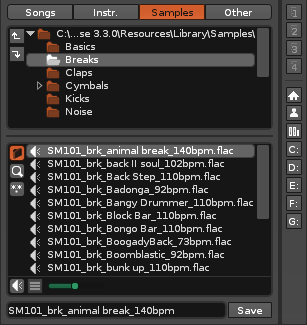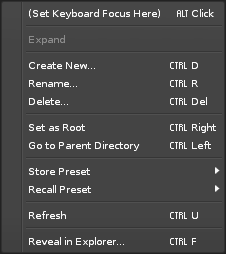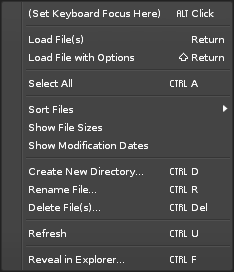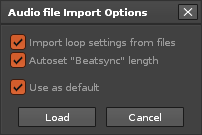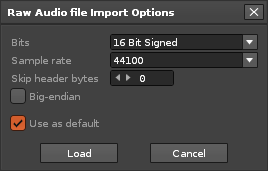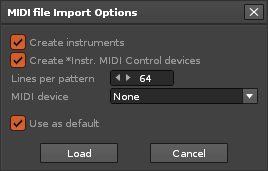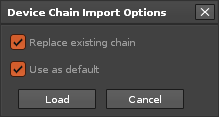Disk Browser: Difference between revisions
imported>Achenar No edit summary |
No edit summary |
||
| (50 intermediate revisions by 5 users not shown) | |||
| Line 1: | Line 1: | ||
= Disk Browser = | = Disk Browser = | ||
The Disk Browser allows you to load and save files | The Disk Browser allows you to load and save files, preview samples or instruments, and store your favourite locations for quick access. In Renoise, it is located at the bottom right corner of the interface. It is closed by default in Redux and is opened by clicking the [[Image:dux1.0_opendiskbrowser.png|text-bottom]] arrow button at the very top right of the interface when in [[Redux_main_screen#The_Full_Editor|full Editor mode]]. | ||
[[Image: | [[Image:3.3_diskbrowser.png]] | ||
== | == Load & Saving Files == | ||
First choose the appropriate file type using the selector tabs shown below. To load a file simply double-click on it in the file list. To save a file, type the desired name into the text box at the bottom and press the Save button. | |||
=== File Type Selector === | |||
Using this panel you select what file type to load or save. Note that the File Panel will display all of the files that are capable of being read, but the files which are relevant to the selected file type are highlighted and listed at the top. | |||
* ''' | * [[Image:3.0_diskbrowser-songs.png]] - ''(Renoise only)'' Load and save Renoise song files (XRNS), or load other song formats that Renoise can import (see below for full list). | ||
* [[Image:3.0_diskbrowser-instruments.png]] - Load and save [[Instruments]] (XRNI files). Clicking the [[Image:3.2_diskbrowser-instrumentsopen.png|baseline]] arrow to the left of an instrument will show any samples contained within, which can then be loaded individually. | |||
* | * [[Image:3.0_diskbrowser-samples.png]] - Load (see below for format list) and save [[Sampler|samples]] (will always save in WAV format). | ||
* | * [[Image:3.0_diskbrowser-other.png]] - Load other file types (saving is done [[Libraries#Specific_Preset_Types|by other means]]). | ||
* | |||
''' | '''Renoise Only''' - Depending on the file type selected, Renoise may also show some additional options & buttons at the bottom: | ||
''' | * '''Song:''' A ''"Render"'' button will appear, which will open the [[Render_Song_to_Audio_File|render window]] and allow you to render the current song as a .wav file. | ||
* '''Instr./Sample:''' A small preview icon that, when enabled, will play samples when they're selected (click the [[Image:3.2_diskbrowser-instrumentsopen.png|baseline]] arrow to the left of an instrument to show any samples contained within). Just to the right of that is another icon that allows you to select whether the sample will be played back on the [[Pattern Editor#Master Track|Master Track]] or the currently selected [[Pattern Editor#Tracks|track]] (including all track [[Effect Chains|effects]]). To the right of that is a slider that adjusts the pre-hear volume - double-clicking it will reset the volume to 0dB. | |||
=== Supported Formats For Song Importing === | |||
*'''.xrns, .rns, .ptk, .ntk''' - Renoise Songs | |||
*'''.xm''' - FastTracker II | |||
*'''.it''' - ImpulseTracker II | |||
*'''.mod''' - Amiga Mod | |||
*'''.mid, .midi''' - standard MIDI | |||
=== Supported Formats For Sample Importing === | |||
* | ==== Lossless ==== | ||
* | *'''.aif, .aiff''' - AIF wave (uncompressed only) | ||
* | *'''.wav''' - PCM wave (uncompressed only) | ||
*'''.fla, .flac''' - Flac audio | |||
*'''.aifc''' - compressed AIF (requires Quicktime) | |||
*'''.au, .snd''' - rare Mac formats (requires Quicktime) | |||
*'''.caf''' - Core Audio file format used by many Apple apps (requires Quicktime) | |||
==== Lossy ==== | |||
*'''.ogg''' - Ogg Vorbis | |||
*'''.wma''' - Windows Media Audio | |||
*'''.ac3''' - Dolby Digital (can be up to 5.1 surround, but only stereo channels will be imported) | |||
*'''.mp2, .mp3''' - standard MP2/3 (requires mpeg123 on Linux) | |||
*'''.m4a, .mp4, .mp4a, .aac''' - new MP4, AAC format (requires Quicktime) | |||
== Folder Panel ''(Renoise only)'' == | |||
Initially, only the current folder will be shown, with the arrow at the right moving the list to the parent directory. To expand the Folder Panel and show the directory tree, either toggle on the folder icon [[Image:3.3_diskbrowser-directories.png|text-bottom]] or click and hold the bar shown below then drag down: | |||
[[Image:3.2_diskbrowser-expandfolderpanel.png]] | |||
The | The Folder Panel gives you an overview of the directory structure. Left-clicking on a folder will display its contents, while double-clicking will enter the folder. | ||
* [[Image: | * [[Image:3.0_diskbrowser-up.png|text-bottom]] - Go up one level in the directory hierarchy. | ||
* [[Image:3.0_diskbrowser-down.png|text-bottom]] - Set current folder as new root directory (only show folders below the current position). | |||
* [[Image: | |||
Right clicking on | Right clicking on a directory within the Folder Panel will also present you with more options: | ||
[[Image:3.0_diskbrowser-foldermenu.png]] | |||
To the right of the folder panel are four numbered buttons, which are user-configurable presets that can be assigned to your favourite file locations. Right-clicking a button will store the current File Panel directory as a preset. Left clicking will recall a previously stored location. Each file type (Song, Instrument, Sample and Other) has its own set of four customisable presets. Hovering over a preset button with the mouse will show its full directory path. | |||
Below this are a set of common default locations: your home folder, the default library folder (different for each file type: Song, Instrument, Sample and Other) and a list of all available installed system drives. | |||
== File Panel == | |||
The | The contents of the selected directory are displayed in the File Panel. By default, only files that are readable by Renoise/Redux are shown. | ||
* [[Image:3.3_diskbrowser-directories.png|text-bottom]] - Toggle showing the Folder Panel. | |||
* [[Image:3.0_diskbrowser-search.png|text-bottom]] - Type in a search phrase to filter the file-list. | |||
* [[Image:3.0_diskbrowser-showall.png|text-bottom]] - When enabled, all file types are shown, not just the ones readable by Renoise/Redux. | |||
* [[Image:3.0_diskbrowser-save.png|text-bottom]] - Save a file (the file is named using the text box to the left of the save button). | |||
Right clicking on any file will present more options: | |||
''' | '''File-Context menu''' | ||
[[Image: | [[Image:3.0_diskbrowser-filemenu.png]] | ||
'' | ''"Load file with options"'' can be used to specify exactly how a file should be imported. The options available to you change depending on the type of file selected. They are as follows: | ||
'''WAV File Import Options''' | |||
[[Image:3.2_diskbrowser-importaudiofile.png]] | |||
'''RAW Audio File Import Options''' | |||
[[Image:3.2_diskbrowser-importrawfile.png]] | |||
'''MIDI File Import Options''' | |||
[[Image:3.2_diskbrowser-importmidi.png]] | |||
'''Device Chain File Import Options''' | |||
[[Image: | [[Image:3.2_diskbrowser-importdevicechain.png]] | ||
== | == Resizing The Interface ''(Renoise Only)'' == | ||
The interface can be expanded horizontally by left-click-dragging the left edge of the panel, and vertically by left-click-dragging on the bar between the [[Instrument Selector#Instrument Properties|Instrument Properties]] and the Disk Browser. | |||
[[Image: | * [[Image:3.2_rightcloseopen.png|text-bottom]] - Closes or opens the entire right panel, hiding both the [[Instrument Selector]] and the Disk Browser. Note that when closed, the visibility icon below will move next to the [[Scopes]] icons, allowing you to still view the [[Instrument Selector]]. | ||
* [[Image:3.2_instrumentselector-visibility.png|text-bottom]] - Toggles the visibility of the [[Instrument Selector]]. | |||
== | == Loading Multiple Entries at Once == | ||
You can | You can load multiple sample or instrument entries by ctrl-clicking individual files and/or shift-clicking to select a range of them. The selected files can then be loaded using the context menu or dragged into a specific spot. Samples can be dragged into the instrument-list area and have an instrument created for each sample, or dragged into the sample-list area and be loaded into a single instrument. | ||
== Navigating the Disk Browser with the Keyboard == | |||
The default keyboard focus is set to control whatever you're working on in the large central section of the interface, but you can also activate other sections for keyboard navigation by any of the following methods: | |||
* Right click on the | * Right click on the File Panel or Folder Panel to show the context menu and select ''"(Set Keyboard Focus here)"''. | ||
* Navigate the keyboard focus through | * Navigate the keyboard focus through the various interface areas with the ''[Control/Command + Tab]'', ''[Control/Command + Shift Tab]'' shortcuts. | ||
* Click with the middle mouse button on the | * Click with the middle mouse button on the File Panel or Folder Panel. | ||
== Importing Raw Audio Files (Convert Any File to Audio Sample) == | |||
It is actually possible to load '''''any''''' file and use it as an audio sample. In order to do this: | |||
* Select | * Select the ''"Sample"'' category in the File Selector. | ||
* Make sure the | * Make sure the ''[[#File Panel|"Show All Files"]]'' option is enabled. | ||
* Double click a file which | * Double click a file which is not normally recognized as a sample file (TXT document, JPEG picture, AVI movie etc.) | ||
* | * Additionally, right-clicking on the file and selecting ''"Load File with Options"'' gives you additional options for importing (sample rate, bit depth etc.) | ||
Latest revision as of 15:55, 3 January 2021
Disk Browser
The Disk Browser allows you to load and save files, preview samples or instruments, and store your favourite locations for quick access. In Renoise, it is located at the bottom right corner of the interface. It is closed by default in Redux and is opened by clicking the ![]() arrow button at the very top right of the interface when in full Editor mode.
arrow button at the very top right of the interface when in full Editor mode.
Load & Saving Files
First choose the appropriate file type using the selector tabs shown below. To load a file simply double-click on it in the file list. To save a file, type the desired name into the text box at the bottom and press the Save button.
File Type Selector
Using this panel you select what file type to load or save. Note that the File Panel will display all of the files that are capable of being read, but the files which are relevant to the selected file type are highlighted and listed at the top.
 - (Renoise only) Load and save Renoise song files (XRNS), or load other song formats that Renoise can import (see below for full list).
- (Renoise only) Load and save Renoise song files (XRNS), or load other song formats that Renoise can import (see below for full list). - Load and save Instruments (XRNI files). Clicking the
- Load and save Instruments (XRNI files). Clicking the  arrow to the left of an instrument will show any samples contained within, which can then be loaded individually.
arrow to the left of an instrument will show any samples contained within, which can then be loaded individually. - Load (see below for format list) and save samples (will always save in WAV format).
- Load (see below for format list) and save samples (will always save in WAV format). - Load other file types (saving is done by other means).
- Load other file types (saving is done by other means).
Renoise Only - Depending on the file type selected, Renoise may also show some additional options & buttons at the bottom:
- Song: A "Render" button will appear, which will open the render window and allow you to render the current song as a .wav file.
- Instr./Sample: A small preview icon that, when enabled, will play samples when they're selected (click the
 arrow to the left of an instrument to show any samples contained within). Just to the right of that is another icon that allows you to select whether the sample will be played back on the Master Track or the currently selected track (including all track effects). To the right of that is a slider that adjusts the pre-hear volume - double-clicking it will reset the volume to 0dB.
arrow to the left of an instrument to show any samples contained within). Just to the right of that is another icon that allows you to select whether the sample will be played back on the Master Track or the currently selected track (including all track effects). To the right of that is a slider that adjusts the pre-hear volume - double-clicking it will reset the volume to 0dB.
Supported Formats For Song Importing
- .xrns, .rns, .ptk, .ntk - Renoise Songs
- .xm - FastTracker II
- .it - ImpulseTracker II
- .mod - Amiga Mod
- .mid, .midi - standard MIDI
Supported Formats For Sample Importing
Lossless
- .aif, .aiff - AIF wave (uncompressed only)
- .wav - PCM wave (uncompressed only)
- .fla, .flac - Flac audio
- .aifc - compressed AIF (requires Quicktime)
- .au, .snd - rare Mac formats (requires Quicktime)
- .caf - Core Audio file format used by many Apple apps (requires Quicktime)
Lossy
- .ogg - Ogg Vorbis
- .wma - Windows Media Audio
- .ac3 - Dolby Digital (can be up to 5.1 surround, but only stereo channels will be imported)
- .mp2, .mp3 - standard MP2/3 (requires mpeg123 on Linux)
- .m4a, .mp4, .mp4a, .aac - new MP4, AAC format (requires Quicktime)
Folder Panel (Renoise only)
Initially, only the current folder will be shown, with the arrow at the right moving the list to the parent directory. To expand the Folder Panel and show the directory tree, either toggle on the folder icon ![]() or click and hold the bar shown below then drag down:
or click and hold the bar shown below then drag down:
The Folder Panel gives you an overview of the directory structure. Left-clicking on a folder will display its contents, while double-clicking will enter the folder.
 - Go up one level in the directory hierarchy.
- Go up one level in the directory hierarchy. - Set current folder as new root directory (only show folders below the current position).
- Set current folder as new root directory (only show folders below the current position).
Right clicking on a directory within the Folder Panel will also present you with more options:
To the right of the folder panel are four numbered buttons, which are user-configurable presets that can be assigned to your favourite file locations. Right-clicking a button will store the current File Panel directory as a preset. Left clicking will recall a previously stored location. Each file type (Song, Instrument, Sample and Other) has its own set of four customisable presets. Hovering over a preset button with the mouse will show its full directory path.
Below this are a set of common default locations: your home folder, the default library folder (different for each file type: Song, Instrument, Sample and Other) and a list of all available installed system drives.
File Panel
The contents of the selected directory are displayed in the File Panel. By default, only files that are readable by Renoise/Redux are shown.
 - Toggle showing the Folder Panel.
- Toggle showing the Folder Panel. - Type in a search phrase to filter the file-list.
- Type in a search phrase to filter the file-list. - When enabled, all file types are shown, not just the ones readable by Renoise/Redux.
- When enabled, all file types are shown, not just the ones readable by Renoise/Redux. - Save a file (the file is named using the text box to the left of the save button).
- Save a file (the file is named using the text box to the left of the save button).
Right clicking on any file will present more options:
File-Context menu
"Load file with options" can be used to specify exactly how a file should be imported. The options available to you change depending on the type of file selected. They are as follows:
WAV File Import Options
RAW Audio File Import Options
MIDI File Import Options
Device Chain File Import Options
Resizing The Interface (Renoise Only)
The interface can be expanded horizontally by left-click-dragging the left edge of the panel, and vertically by left-click-dragging on the bar between the Instrument Properties and the Disk Browser.
 - Closes or opens the entire right panel, hiding both the Instrument Selector and the Disk Browser. Note that when closed, the visibility icon below will move next to the Scopes icons, allowing you to still view the Instrument Selector.
- Closes or opens the entire right panel, hiding both the Instrument Selector and the Disk Browser. Note that when closed, the visibility icon below will move next to the Scopes icons, allowing you to still view the Instrument Selector. - Toggles the visibility of the Instrument Selector.
- Toggles the visibility of the Instrument Selector.
Loading Multiple Entries at Once
You can load multiple sample or instrument entries by ctrl-clicking individual files and/or shift-clicking to select a range of them. The selected files can then be loaded using the context menu or dragged into a specific spot. Samples can be dragged into the instrument-list area and have an instrument created for each sample, or dragged into the sample-list area and be loaded into a single instrument.
The default keyboard focus is set to control whatever you're working on in the large central section of the interface, but you can also activate other sections for keyboard navigation by any of the following methods:
- Right click on the File Panel or Folder Panel to show the context menu and select "(Set Keyboard Focus here)".
- Navigate the keyboard focus through the various interface areas with the [Control/Command + Tab], [Control/Command + Shift Tab] shortcuts.
- Click with the middle mouse button on the File Panel or Folder Panel.
Importing Raw Audio Files (Convert Any File to Audio Sample)
It is actually possible to load any file and use it as an audio sample. In order to do this:
- Select the "Sample" category in the File Selector.
- Make sure the "Show All Files" option is enabled.
- Double click a file which is not normally recognized as a sample file (TXT document, JPEG picture, AVI movie etc.)
- Additionally, right-clicking on the file and selecting "Load File with Options" gives you additional options for importing (sample rate, bit depth etc.)
